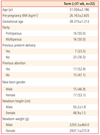1. Go YJ. Phthalate safety supervision countermeasure in child article. Proceedings of the 32th Korean Society of Health Promotion Conference. 2007. 2007 Nov 9; Seoul, Korea. Seoul: The Korean Society of Health Promotion;163–166.
2. Shin HS, Pyo HS. Behavior of Phthalate in environment and biology. Proceedings of the 32th Korean Society of Health Promotion Conference. 2007. 2007 Nov 9; Seoul, Korea. Seoul: The Korean Society of Health Promotion;168–194.
3. Kim TH, Hong YP. Endocrine disruptor and menopause. J Korean Soc Menopause. 2010. 16:1–5.
4. Lintelmann J, Katayama A, Kurihara N, Shore L, Wenzel A. Endocrine disruptors in the environment (IUPAC technical report). Pure Appl Chem. 2003. 75:631–681.
5. Caserta D, Maranghi L, Mantovani A, Marci R, Maranghi F, Moscarini M. Impact of endocrine disruptor chemicals in gynaecology. Hum Reprod Update. 2008. 14:59–72.
6. Nagel SC, vom Saal FS, Thayer KA, Dhar MG, Boechler M, Welshons WV. Relative binding affinity-serum modified access (RBA-SMA) assay predicts the relative in vivo bioactivity of the xenoestrogens bisphenol A and octylphenol. Environ Health Perspect. 1997. 105:70–76.
7. Sheehan DM, Willingham E, Gaylor D, Bergeron JM, Crews D. No threshold dose for estradiol-induced sex reversal of turtle embryos: how little is too much? Environ Health Perspect. 1999. 107:155–159.
8. Yang M, Park MS, Lee HS. Endocrine disrupting chemicals: human exposure and health risks. J Environ Sci Health C Environ Carcinog Ecotoxicol Rev. 2006. 24:183–224.
9. Stewart PW, Lonky E, Reihman J, Pagano J, Gump BB, Darvill T. The relationship between prenatal PCB exposure and intelligence (IQ) in 9-year-old children. Environ Health Perspect. 2008. 116:1416–1422.
10. Colon I, Caro D, Bourdony CJ, Rosario O. Identification of phthalate esters in the serum of young Puerto Rican girls with premature breast development. Environ Health Perspect. 2000. 108:895–900.
11. Wolff MS, Britton JA, Boguski L, Hochman S, Maloney N, Serra N, et al. Environmental exposures and puberty in inner-city girls. Environ Res. 2008. 107:393–400.
12. Yang CY, Yu ML, Guo HR, Lai TJ, Hsu CC, Lambert G, et al. The endocrine and reproductive function of the female Yucheng adolescents prenatally exposed to PCBs/PCDFs. Chemosphere. 2005. 61:355–360.
13. Crain DA, Janssen SJ, Edwards TM, Heindel J, Ho SM, Hunt P, et al. Female reproductive disorders: the roles of endocrine-disrupting compounds and developmental timing. Fertil Steril. 2008. 90:911–940.
14. Foster WG, Neal MS, Han MS, Dominguez MM. Environmental contaminants and human infertility: hypothesis or cause for concern? J Toxicol Environ Health B Crit Rev. 2008. 11:162–176.
15. Wigle DT, Arbuckle TE, Turner MC, Berube A, Yang Q, Liu S, et al. Epidemiologic evidence of relationships between reproductive and child health outcomes and environmental chemical contaminants. J Toxicol Environ Health B Crit Rev. 2008. 11:373–517.
16. Irvin EA, Calafat AM, Silva MJ, Aguilar-Villalobos M, Needham LL, Hall DB, et al. An estimate of phthalate exposure among pregnant women living in Trujillo, Peru. Chemosphere. 2010. 80:1301–1307.
17. Berman T, Hochner-Celnikier D, Calafat AM, Needham LL, Amitai Y, Wormser U, et al. Phthalate exposure among pregnant women in Jerusalem, Israel: results of a pilot study. Environ Int. 2009. 35:353–357.
18. Faouzi MA, Dine T, Gressier B, Kambia K, Luyckx M, Pagniez D, et al. Exposure of hemodialysis patients to di-2-ethylhexyl phthalate. Int J Pharm. 1999. 180:113–121.
19. Doull J, Cattley R, Elcombe C, Lake BG, Swenberg J, Wilkinson C, et al. A cancer risk assessment of di(2-ethylhexyl)phthalate: application of the new U.S. EPA risk assessment guidelines. Regul Toxicol Pharmacol. 1999. 29:327–357.
20. Takatori S, Kitagawa Y, Kitagawa M, Nakazawa H, Hori S. Determination of di(2-ethylhexyl)phthalate and mono(2-ethylhexyl) phthalate in human serum using liquid chromatography-tandem mass spectrometry. J Chromatogr B Analyt Technol Biomed Life Sci. 2004. 804:397–401.
21. Inoue K, Yamaguchi A, Wada M, Yoshimura Y, Makino T, Nakazaw H. Quantitative detection of bisphenol A and bisphenol A diglycidyl ether metabolites in human plasma by liquid chromatography-electrospray mass spectrometry. J Chromatogr B Biomed Sci Appl. 2001. 765:121–126.
22. Koo HJ, Lee BM. Estimated exposure to phthaiates in cosmetics and risk assessment. J Toxicol Environ Health A. 2004. 67:1901–1914.
23. Koch HM, Bolt HM, Angerer J. Di(2-ethylhexyl) phthalate (DEHP) metabolites in human urine and serum after a single oral dose of deuterium-labelled DEHP. Arch Toxicol. 2004. 78:123–130.
24. Park MS, Yang YJ, Hong YP, Kim SY, Lee YP. Assessment of di (2-ethylhexyl) phthalate exposure by urinary metabolites as a function of sampling time. J Prev Med Public Health. 2010. 43:301–308.
25. Clark MF, Reade MC, Boyd CA, Young JD. Effects of endotoxin exposure on cationic amino acid transporter function in ovine peripheral blood mononuclear cells. Exp Physiol. 2003. 88:201–208.
26. Weuve J, Hauser R, Calafat AM, Missmer SA, Wise LA. Association of exposure to phthalates with endometriosis and uterine leiomyomata: findings from NHANES, 1999-2004. Environ Health Perspect. 2010. 118:825–832.
27. Patisaul HB, Adewale HB. Long-term effects of environmental endocrine disruptors on reproductive physiology and behavior. Front Behav Neurosci. 2009. 3:10.
28. Adibi JJ, Hauser R, Williams PL, Whyatt RM, Calafat AM, Nelson H, et al. Maternal urinary metabolites of Di-(2-Ethylhexyl) phthalate in relation to the timing of labor in a US multicenter pregnancy cohort study. Am J Epidemiol. 2009. 169:1015–1024.







 PDF
PDF ePub
ePub Citation
Citation Print
Print




 XML Download
XML Download